Out on Breezy Point on the Rockaway peninsula, people know and like Jim Killoran, and not just for the kind of blue-eyed Irish surname that earns one a familiar welcome in this tight-knit oceanfront community known as the Irish Riviera.
Nor is it just the sight of the ubiquitous blue pickup truck he drives with the “HABITAT7” plates and the Habitat for Humanity lettering and blueprint design on its panels that has contractors waving and the retired N.Y.P.D. cop who took a bullet in the spine braking to shoot the breeze with the ever-amiable and earnest Killoran.
People in Breezy Point, and in other battered communities across The Rockaways, know Jim Killoran as the man who came from Westchester County in the first terrible days after Hurricane Sandy with badly needed supplies ”“ food and water and gasoline, lumber and building supplies and heavy-duty contractor trash bags ”“ and volunteers to tackle the muck and mounds of wet sand in their ruined homes and businesses. As executive director of Habitat for Humanity of Westchester, he came with an organization practiced and resourceful in responding to natural disasters. The flood disaster of April 2007 that ravaged Mamaroneck and other Westchester communities was Killoran”™s and Habitat”™s training ground.
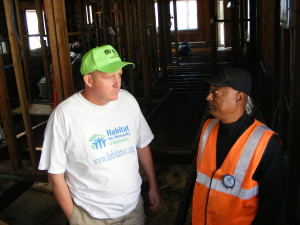
- Habitat for Humanity of Westchester’s Jim Killoran, left, and Seshadri Venkatachari in Breezy Point.
One year later, Sandy”™s survivors on the Queens shore know him and his crews as the ones who have stayed to help rebuild both homes and hope in Breezy Point. They have stayed long after many have left. Some left with profits from shoddy, incompetent repair work that Habitat work crews have had to undo.
“I call this Westchester East, the Rockaways and Breezy Point,” said Killoran, whose Habitat chapter based in Mamaroneck marks its 25th anniversary this year.
While the recovery work continues on this outer reach of New York City, Killoran with his Habitat volunteer crews and business partners also is stepping up projects in Westchester to build, reclaim and repair homes for returning military veterans and other residents in need of affordable ownership housing. Rather than a distraction from its Westchester mission, Habitat”™s effort in the Rockaways has strengthened and expanded its infrastructure of corporate partners, donors and volunteers for the work in its home county, he said.
“We are building nine homes now, from Peekskill to Yonkers and White Plains ”“ new and rehabbed ”“ and with foreclosures up, we anticipate getting empty homes, rehabbing and putting more families in as well,” said Killoran. With the nonprofit”™s 25th anniversary, “I made a commitment that we would build even more in Westchester this year.”
“Everyone thinks everybody”™s in,” Killoran said as we drove Rockaway Point Boulevard on a warm and sunny October day in Breezy Point, a homeowners cooperative that dates to 1960. “There are still thousands of people not in their homes one year later ”“ and we”™re in the capital of the world.”
“It”™s pretty surreal,” he said as we passed a bustling construction site on the community”™s ocean side where two-story homes sheathed in plywood were rising on sandy ground in a neighborhood leveled by fire and flood. “But in a minute it could happen in Sound Shore, in Hartsdale, in Yonkers.”
At Breezy Point, whose narrow side streets of tightly clustered one-story homes are not accessible by auto, “I think 40 percent at most is back,” he said. About 300 homes either were destroyed in the spectacular fire that riveted a watching metropolis and nation on the night of the hurricane or were knocked down in the wake of severely damaging high winds and salty floodwater.
“I had about 75 houses around me,” said Betty Jean Darby, who had stopped at Christ Community Church, the white-steeple summer church that serves as Habitat for Humanity”™s operations center. She was looking for help to get a special Federal Emergency Management Agency grant she needs to raise her house above flood level. “I”™m one of the few still standing”¦ The wind blew the door down. I had 13 feet of water in a one-story home.” And four feet of wet sand that volunteers removed.
“They”™re wonderful,” she said of Habitat. “Without volunteers, I would never have survived. I”™m not alone in that.”
To get the FEMA grant, Darby and other homeowners must first obtain a letter from New York City officials certifying the substantial damage to their homes. “It”™s a nightmare to get the letter,” she said.
For disaster-stricken residents navigating government channels, Killoran said, “You need a lawyer just to understand the gobbledyspeak.”
For Darby, “It was $20,000 for the engineer and the architect” whose services were needed to qualify for the grant.
“Mine, they say it”™s $23,000” for those professional services, said Stacy Walsh, a Rockaways hurricane victim who works daily at the Habitat center. She wears a brace on her upper torso and awaits more surgery after a car accident in June left her with a fractured skull and 200 head stitches, three cracked vertebrae, a pair of broken knees and a broken hip. “I only had $80,000 in insurance” on her home, she said.
Walsh and her family have been helped financially by Habitat, which itself relies wholly on donations, even as she dispenses aid and knowing sympathy to other victims. Alison Giglio, a Cross River resident whose relief group in northern Westchester, H2H or Hand to Heart, has sent hundreds of volunteers and donations of money and supplies to Habitat”™s Rockaways operation, calls Walsh “the Habitat hero.”

- Construction manager Sesh Venkatachari checks his crew’s progress in a Breezy Point home being renovated by Habitat for Humanity of Westchester.
In Habitat”™s Westchester East work, “We”™ve had 8,500 volunteers overall, at least,” said Killoran. “We figure we did over $12 million of work out here with the volunteers” in labor and donations. “We”™ve touched over 800 homes” in the various stages of recovery, from mucking to gutting to painting and renovating. “That”™s actually closer to 1,000,” he added. Habitat crews have gutted and helped rebuild a dozen businesses.
One of those is Breezy Point Lumber Co., whose busy lot adjoins the cooperative”™s one-stop strip shopping center, which also serves as residents”™ post-storm information exchange.
Owner Kathy Dady, who took over the business after her husband died two years ago, was observing the anniversary of his death on the day that Hurricane Sandy hit. On the first mournful anniversary the previous year, a freakish snowstorm swept in. “We”™re hoping he”™s a bit quiet this year,” the widow said with a rueful smile.
In the storm”™s aftermath, “This was definitely the hospital” for a community in need of emergency repairs, she said. But for two weeks the hospital itself was closed and in recovery.
“The water was five feet high,” said Dady, pointing out the flood level on a drill bits display case. “I lost most of my inventory” along with computers, company trucks and a lumber yard forklift. “Jim sent a bunch of guys out to help me”¦They were very instrumental in helping me open the doors again.”
“We had tons of Master Card employees here,” she said. The company sent six busloads of employees to join the volunteer troops deployed by Killoran across the Rockaways. They were among the many corporate good citizens from Westchester donating equipment, materials and labor to the Habitat team.
Dady also turned to Westchester when replacing her company fleet, buying a truck from a Port Chester lumber company that was going out of business.
We crossed a parking lot to the shopping center”™s Blarney Castle Tavern. Jerry O”™Hara ”“ a Vietnam veteran with two prosthetic legs for whom Killoran is trying to find a three-wheeled motor scooter to help him across the shifting sand outside his Habitat-renovated home ”“ was tending bar. He had just gotten off his shift at Blarney Castle when Sandy blew in a year ago.

- A Breezy Point church is Habitat for Humanity’s operations center in the Rockaways. From left, Jim Killoran, executive director, and volunteers Stacy Walsh and Tom Naughton.
“We watched it from here,” O”™Hara said. Across the boulevard, 146 homes went up in flames, out of the reach of the community”™s volunteer fire department immobilized by the flood. “We”™re sitting here and watching Breezy burn and not being able to do anything about it.”
The tavern was largely spared, but its day bartender was left homeless.
“I got into my house after eight months and it was mostly due to the Habitat,” O”™Hara said. “They did a great job for me. It wasn”™t just me, it was the whole neighborhood that they helped. They helped us out tremendously. Some of the craftsmen, they brought in.”
“It”™s like a deployment of troops,” Killoran said of the disaster operation, “in this case volunteer troops who”™ve been with us for years.”
One year after the hurricane, Habitat has Walsh and four other volunteers working daily in the Rockaways. They include Tom Naughton, a retired Bank of New York employee with a useful pickup truck. Naughton thought he had it bad when the lights and heat went out for 12 or 13 days at his home in Rye Brook, until he came to Breezy Point. He drives there five or six days each week.
Habitat”™s volunteer construction manager, Sesh Venkatachari, has hired 12 unemployed Rockaway residents as full-time and part-time workers on Habitat”™s rebuilding crews. Some, like Ray Acosta, an auto parts store employee in Rockaway for 23 years, lost their jobs when Sandy put their employers out of business.
A resident of Richmond Hill in Queens, Venkatachari was a former stockbroker in his native India and a foreign exchange trade consultant to New York banks when Sandy hit. “I came here the third day of Sandy,” he said in Breezy Point. “I quit my job the second day.” Now Habitat”™s good work is his daily work.
“He”™s a miracle,” the construction manger said of Killoran. “People make things happen; that”™s him.” Though Breezy Point now looks more “like a little town” than the “disaster zone” it was a year ago, “He is still in the disaster mode,” Venkatachari said.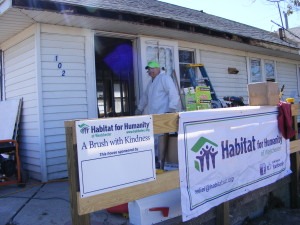
Outside a gutted home where a Habitat crew worked, Killoran in his braking truck shouted with joy at seeing a backhoe operator remove a massive uprooted tree stump from the property.
“He”™s got a house in the Rockaways that we”™re gonna help,” said Naughton, who negotiated the curbside deal.
Killoran quickly reached for his wallet in his shorts pocket and handed cash to Naughton. “Here, give him this,” he said. “It is New York.”
He reached again for his wallet and pulled out another bill. “Here, Tommy, get him lunch too,” he instructed.
At Habitat, “We”™re not here for money,” he said. “We”™re just here to get people in their homes.” “When groups came and went, we stayed,” said the man from Westchester they know and like in Breezy Point. “Every day is make a difference day.”





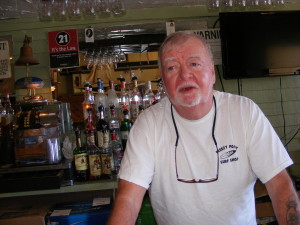
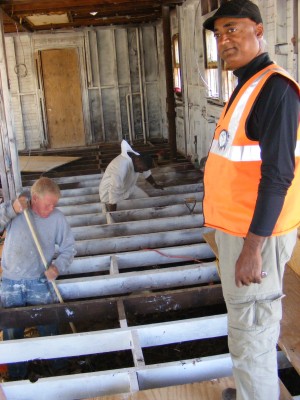
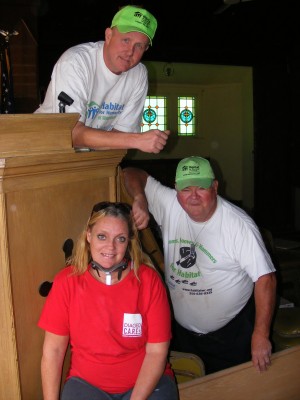
















If not for Jim, Bishop Gibbs and ALL THE VOLUNTEERS of Habitat for Humanity Westchester I would not be back in my home today. Through His/their dedication, unending work and pure heart they helped to ease what was a catastrophe just a bit easier to cope with THE THANK YOU’s to them all cannot be big enough – Danny Breezy Point NY
Great article! Thanks to the Westchester Business Council for reporting on the anniversary of Hurricane Sandy.
Sorry, make that Westchester Business Journal!!
I personally volunteered my services for Jim and H for H. My time and my services. On a Saturday morning exactly a year ago he sent me to a job that was completely unorganized. Tools were all locked up, No skilled labor present to provide instruction and a handful of kids in sneakers looking to log community hours and nothing else. Certainly not ready to work. Calls to Jim direct went unanswered. If the lack of communication and organization is the same out on the Island as it is in Westchester, then I doubt anything was accomplished. Jim talks a good game, that is about it.
Great work! Best wishes and prayers for well being of all at Habitat for Humanity!
Larry,your comment is a disservice to all the hard work that Jim and others from Habitat have put in to help rebuild Breezy Point.It is hard to imagine that one would talk about their one personal experience as Habitat continues to rebuild and other ,not all organizations have done little.Jim and Habitat have given hope to people..who thought that things were hopeless.They are an amazing group. Shame on you Larry.You obviously do not know Jim!